How to Create Restaurant Merchandise Guests Will Obsess Over
5 min read
May 28, 2025

5 min read
May 28, 2025

Forget the dusty shelf of logoed t-shirts by the host stand. Restaurant merchandise has evolved into a high-impact brand tool—part storytelling, part revenue and part lifestyle.
Driven by rising guest expectations and bold operator creativity, merch today isn’t just about selling something—it’s about sharing a belief. A vibe. A story people want to be part of.
According to the SevenRooms 2025 Restaurant Industry Trend Reports, 82% of diners globally said they’d purchase a different type of offering from a restaurant.
This article explores the types of restaurant merch diners are craving, paired with creative examples from hospitality brands around the world. We also spoke with Jacob Cross, Managing Director at Roy—a leading restaurant branding and design agency in New York City and San Francisco—about what it really takes to create swag that sells.
Merchandise today shouldn’t be an afterthought—it’s part of the holistic guest experience.
“Guests are spending more and expecting more,” said Jacob Cross. “They want to feel considered at every touchpoint—not just the food, but the interiors, the uniforms and the merch.”
For modern diners, especially millennials and Gen Z, that consideration goes beyond aesthetics. It’s about alignment with values and a desire for authenticity.
“Millennials were the first generation with real buying power that wanted to align with brands that shared their values,” said Jacob. “Now Gen Z is saying: don’t just tell me, show me. If transparency is one of your values, I need to see it. Show me where your ingredients come from. How you treat your staff. What your brand actually stands for.”
This is where great branding and great merchandise meet. A t-shirt with your chef’s quote. A candle that smells like your signature cocktail. An apron that mirrors your commitment to quality. These are more than souvenirs—they’re symbols of what you stand for.
“Every restaurant we work with has its own dream and vision behind it,” said Jacob. “And the best merch taps into that. It connects the guest to the why behind the brand.”
As operators look for new ways to build loyalty and drive visibility, storytelling through merch offers something powerful: a tangible piece of your brand identity that travels with your guests, sparks conversations and brings them back again.
Today’s most beloved restaurant merchandise blends quality, creativity and brand alignment. And sometimes, it surprises.
As Jacob Cross put it: “We’ve seen everything from temporary tattoos to branded chopsticks and even baby onesies. It works when it’s tied to the concept. The only way merch doesn’t work is if it’s not thoughtful and not quality.”
Here’s what it looks like when restaurants get it right.
When designed well, aprons aren’t just for the kitchen—they’re statement pieces that signal craftsmanship and care.
At etch., a refined modern British restaurant in the UK, Chef Steven Edwards sells the same 100% organic cotton aprons his team wears in the kitchen, made by Oliver Harvey.
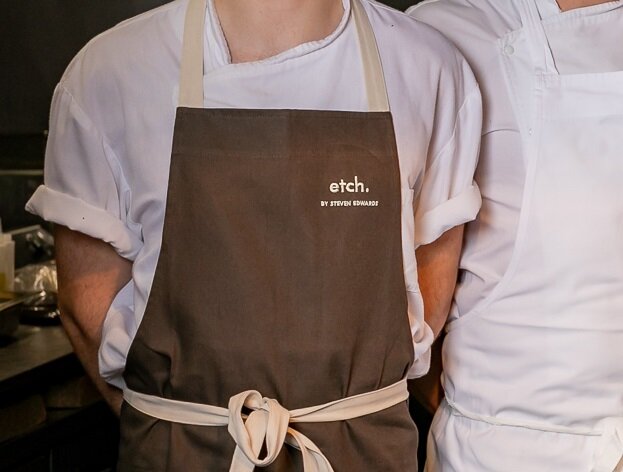
“For us, it felt like a natural extension of the experience at etch. It’s a great way for our guests to take home a souvenir and enhance the memory of their visit,” he said. “They’re the same aprons our chefs wear in the kitchen, known for their durability and design. It’s about offering our guests something authentic that represents what we stand for."
Forget boxy tees with clip-art logos. Today’s t-shirts, hoodies, crewnecks and beanies are cut from high-quality cloth and built for fashion-minded diners.
“The style of hats has changed. The fabrics. The fit,” said Jacob. “If you want people to wear your merch, it has to feel like something they’d buy even without your name on it.”

At Bla Bla Dubai—a high-energy beachfront dining and nightlife destination—the branded restaurant merchandise line reflects their cheeky personality. Guests can purchase bold gear like “Duck Off” t-shirts and hats that feel like trendy streetwear.
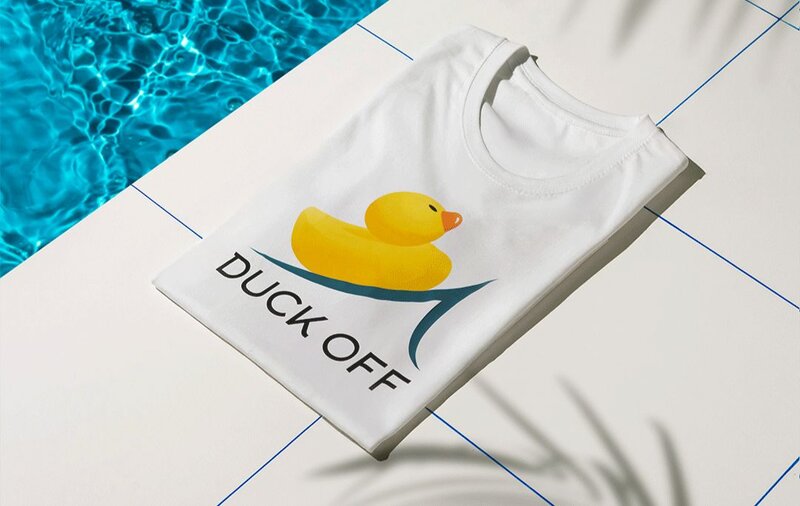
“Our merchandise showcases our casual yet fun approach to life,” said guest relations manager Rheinardt Britz. “We ask ourselves one simple question: would I wear this to the shops?”
A great tote is reusable, practical and makes a quiet design statement. It’s also a walking billboard—one guests will gladly carry if the look and quality are right.
At Dishoom, a beloved Indian restaurant group in London known for its richly detailed design and storytelling, every piece of merch is part of a broader brand narrative. Their robust online store features stylish branded tote bags, along with a vast array of branded retail, books and homegoods that extend the multisensory dining experience.
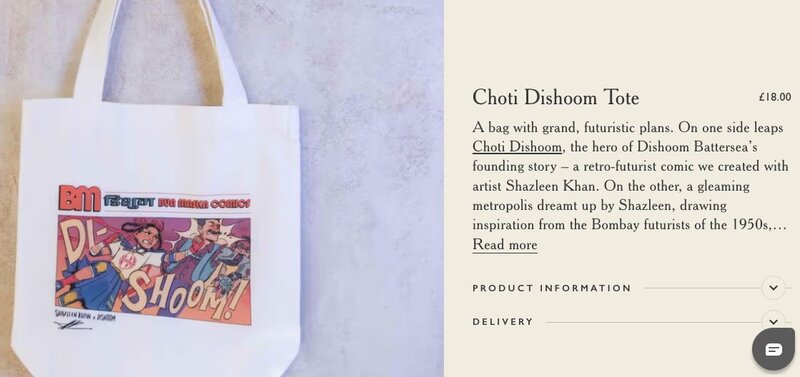
Some guests want to cook with you—literally. From jarred sauces and olive oils to full cookbooks and DIY kits, pantry-friendly merch helps recreate the restaurant magic at home.
At Dishoom, meal kits let diners make signature dishes like their house bacon naan rolls from scratch. Their online store also features an award-winning cookbook that extends the brand’s rich storytelling and flavor into the home kitchen.
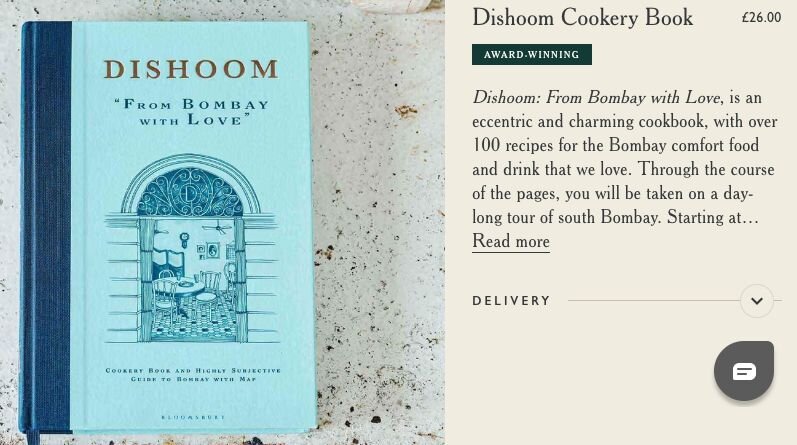
At Aalia in Sydney, guests can take home bottles of Paul Farag x Rio Vista olive oil or a curated Medjool Date Box—both available as add-ons during the booking process.
“Our guests often connect with the flavours, ingredients and ethos behind our food, so offering something tangible felt like a natural progression,” said Natasha Hasna, Projects and Events Manager. “It’s a way to bring a bit of Aalia home.”
Great restaurant merch doesn't stop at the plate. Candles, hand wash, soaps and incense offer guests a way to relive the restaurant’s mood and memory at home.
Quay, one of Sydney’s most iconic fine dining restaurants, created a signature candle that evokes the venue’s refined sensory experience.

At Dishoom, guests can buy branded hand wash, body wash and signature incense sticks—each crafted to match the warm, spice-laden ambiance of their restaurants.
“Some restaurants are even turning signature cocktails into scented candles,” said Jacob. “A way to recreate the memory through smell, not just taste.”
From bottle openers to water bottles and tumblers, everyday utility items offer staying power—especially when they’re designed with care.
At Bla Bla, functional meets fun with custom glassware designed with their signature JBR skyline— an unbreakable wine glass that’s as bold and playful as the venue itself—perfect for beachgoers and brand fans alike.
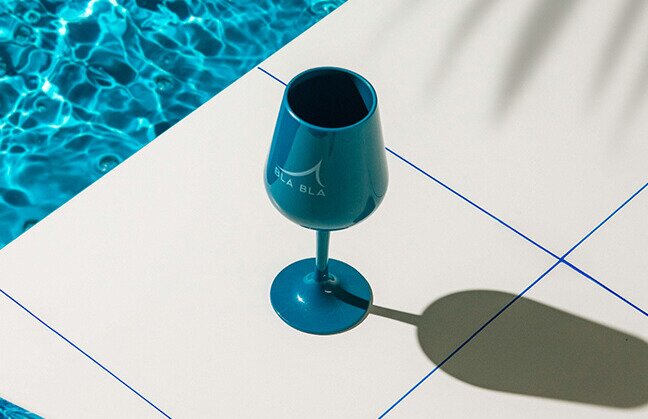
At Roy, Jacob Cross and his team have helped countless restaurants successfully launch merch. Here are a few of his expert tips.
Merch should grow from your brand—not float beside it. Start by looking inward: What do you stand for? What are the signature elements of your space, your service, your story?
“Don’t just throw your restaurant logo on a t-shirt,” said Jacob. “Is there a chef’s quote? A phrase you always use? A visual that captures your vibe? That’s where the story begins.”
The most successful merch is tied directly to the operation and philosophy behind it. At etch., Chef Steven Edwards chose to sell the same cotton aprons his team wears in the kitchen.
“It wasn’t about creating a merchandise line for the sake of it,” said Edwards. “It’s about sharing what’s genuinely part of the experience.”
Before you make anything, ask yourself: Would I use this? Would my team wear it? Would a guest be proud to own it?
Choosing what to sell starts with knowing who you're selling to.
“When you understand what your guests connect with emotionally, it becomes easier to create something they want to take home,” said Jacob.
With a CRM like SevenRooms, restaurants can use guest data to uncover preferences, dining habits and even specific guest conversations that reveal what resonates.
“Our products had to feel like a natural extension of what we do—not just merchandise for the sake of it,” Rachel from Aalia explained. “We looked at what guests love most during their visit and chose products that tell a deeper story.”
This kind of insight can help you translate signature dishes, special occasions and emotional connections into products guests actually want.
The easiest way to know if something works? Wear it. Use it. See if guests notice.
“You can design something for the uniform and then also sell it to guests,” said Jacob. “There are so many concepts now that are double leveraging that—if the staff’s already wearing it, and guests are asking for it, why not sell it?”
Uniforms can double as product testing—and real-time marketing.
Merch can show up in a number of places—inside your restaurant, at the table, during checkout or even before the guest arrives.
At Aalia in Sydney, and in many of the examples above, merchandise is woven directly into the booking experience as add-ons through SevenRooms’ reservation widget.
“We saw it as an opportunity to enhance the guest journey from the very beginning,” said Natasha. “By integrating it into the booking widget, we’re able to offer a seamless, curated experience—whether someone’s celebrating a special occasion or just wants a thoughtful memento. It’s also helped drive early engagement, boosted revenue per booking and elevated the overall perception of what dining at Aalia can be.”
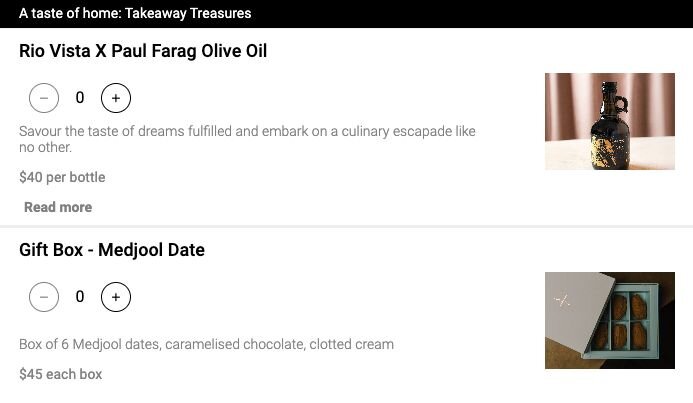
It’s a low-lift, high-impact starting point that works within your existing systems and adds value before the guest even walks through the door.
For a more advanced play, look to Dishoom, whose robust online store allows anyone, at anytime, to browse and purchase their full retail line.
Creating merch is only half the job. The other half? Making sure guests know about it—and want it.
Merch is a marketing asset, and how you promote it should reflect your brand’s voice and style. Consider:
Done right, merchandise becomes more than an add-on—it’s a brand awareness asset that builds loyalty, sparks conversation and keeps your restaurant top of mind. As Jacob puts it:
And if you're looking to do it right from the start, consider partnering with a branding agency like Roy. From concept to execution, his team can help turn your ideas into something guests actually want to wear, use and remember.
“You’re sending walking billboards out into the world. It’s marketing you don’t have to pay for again.”